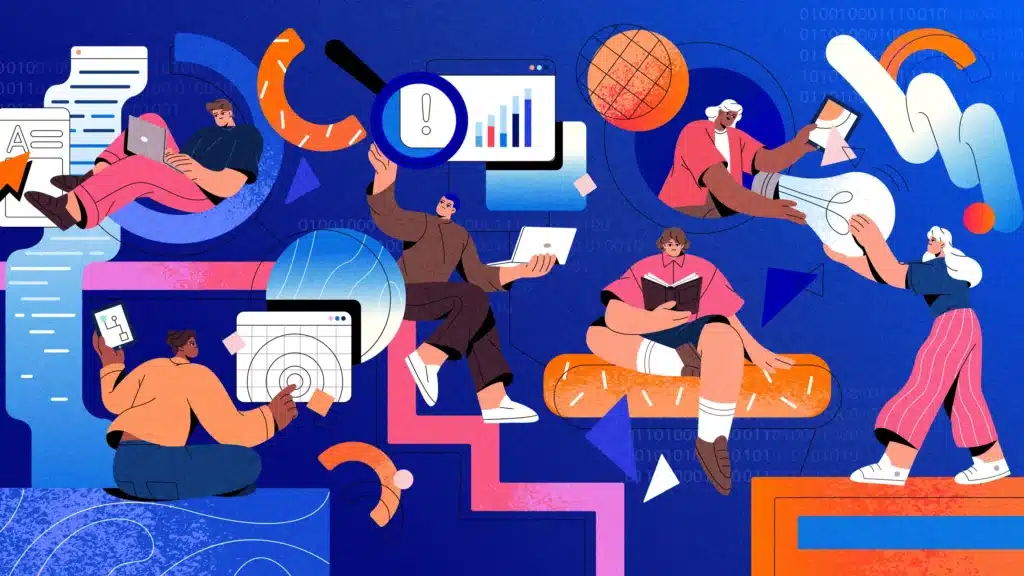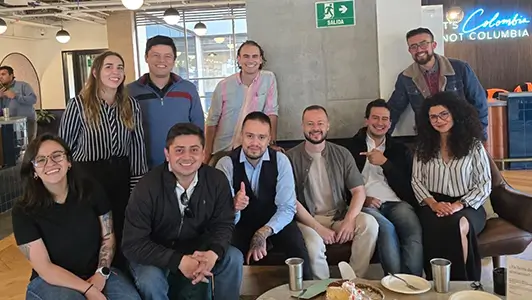Guide
When AI speeds things up, humans must slow down and collaborate
- Discover how to turn AI speed into stronger outcomes by leading with trust and collaboration. Learn the four choices leaders face under pressure and five steps to build resilient teams in an AI-driven workplace.

Whether we know it or not, we all negotiate at work every day with each new ask and each new change.
I’m not just referring to high-stakes contract negotiations. Think about the daily moments that require aligning priorities, navigating trade-offs, and collaborating to achieve a common goal. That’s negotiation, which, when done well, looks a lot like a deep form of collaboration.
But just as artificial intelligence (AI) promises to help us gain efficiency and productivity, human collaboration has never been more critical or more strained: competing goals, ambiguous ownership, external impacts, fragile trust, and the need to build alignment without clear authority. We avoid hard conversations in favor of performative alignment. We nod heads and keep thoughts to ourselves. We escalate too quickly or not at all. We push instead of partner to keep the peace. Each of these dilute outcomes as well as trust, which is the very foundation of effective collaboration that AI cannot solve for us.
A recent MIT Sloan review revealed that human-AI teams only outperform when each does what they do best. That means humans must own the work of navigating nuance, trust, and meaning. These are skills core to ethical leadership, durable decision-making, and resilient culture.
Even as AI forces us to evolve the very definition of work, outcomes still depend on human relationships: people working across silos, reconciling competing interests, and building shared understanding and solutions under mounting pressures and external dynamics. Simply put, AI might speed up how we work, but humans still must think, navigate, and drive decisions and outcomes together.
The 4 choices leaders face under pressure
The modern workplace is a web of increasing complexity and relentless volatility. Strategies and plans rarely stay static, and people each pursue their own definition of success while juggling relationships, culture, and competing priorities.
Picture a scenario one of your teams is likely to encounter: The team is charging toward a critical deadline with high visibility. Suddenly, market shifts alter business needs. Delay isn’t an option. The leader could push their team harder, or pull in resources from another team.
One of their peers has exactly what they need: skillsets and capacity. However, asking for it could put their commitments at risk, or strain the relationship and trust. Now what?
There are four choices:
1
Compete
Escalate to get more resources. You may win, but it can cost relationships and lasting resentment.
2
Concede
Avoid conflict and push the existing team harder. A short-term solution that risks damage to quality and morale.
3
Compromise
Ask a friendly peer for partial support. Even if they want to help (this feels safe!), both leaders have taken on risk.
4
Collaborate
Find a peer who has what is needed AND has unmet needs of their own. By co-creating a solution that solves both leaders’ problems, they achieve a win-win. Though harder and longer to solve, both leaders will have stronger outcomes AND a deeper relationship.
If you find yourself cringing at Option 4, you’re not alone. People often find collaboration to be a slow, frustrating, and unproductive process. That’s why silos persist, decisions are still made in isolation, and trust continues to erode. But when outcomes and relationships both matter, collaboration is exactly where we must start.
The collaboration paradigm
In Getting to Yes by Fisher & Ury, there are four common negotiating styles.
We move between these styles depending on context and culture. While all are useful in certain situations, in our increasingly interconnected work environments, a collaborate-first mindset is critical.
This level of collaboration is what I refer to here as profound collaboration: this is far deeper than alignment meetings or status updates. It’s grounded in shared understanding, mutual respect, and real joint problem-solving.
To get there, you need humans who are motivated, trusted, and empowered to go on the journey of building clarity and uncovering solutions together. Of course, you can leverage AI to support the subtasks such as synthesizing inputs, modeling options, and testing your insights which can provide more focus for the uniquely human parts of negotiation.
Motivation, incentives, and the missing piece
Motivation is not sparked by pressure or perks—true intrinsic human motivation at work is rooted in trust and fairness. Without trust, there is very little you can do to motivate others to get on board with you.
Incentives matter too. Collaborative negotiation flourishes when both sides bring unmet needs to the table that they can’t fulfill alone.
And here’s what many miss:
Collaborative negotiation starts with empathy, not leverage.
You must empathize with what matters to others and discuss where your partnership can unlock value for you both.
With all the pieces in place, you have the potential to create and fuel a virtuous cycle:
trust → profound collaboration → better outcomes and deeper relationships → deeper trust.
5 steps to negotiate collaboratively
When outcomes and relationships both matter, here’s how to approach collaborative negotiation in practice:
1. Create clarity for yourself
Clarify your goals, priorities, and non-negotiables. Anticipate others’ needs AND what they can’t do alone.
→ Consider AI to test your ideas by modeling scenarios and constraints, as well as to simulate trade-offs and risk.
2. Connect & seek understanding
Share your perspective, ask open questions, and listen. What are their pain points? What would success look like for them?
→ Consider AI to help with research and enrich your understanding, but remember: only humans build rapport and trust.
3. Co-create solutions
Explore options together. What can you build that neither could accomplish alone?
→ AI can help refine your drafts, synthesize content, or iterate on ideas, but humans must judge feasibility and value
4. Agree on terms
Confirm expectations, responsibilities, and backup plans if commitments shift.
→ Consider AI to help you consolidate and refine your drafted agreement, but the agreement must be made person to person.
5. Implement & adjust
Check in. Is it working? Adapt as needed, and revisit prior steps as the situation evolves.
→ AI can help you generate a checklist and reminders, and remodel as changes arise.
Collaboration is how we build resilient organizations
If you’ve ever thought, “Collaboration is a waste of time,” you’re not alone.
Durable outcomes and resilient relationships and partnerships come from deeper work based on trust and shared success.
Profound collaboration isn’t just how we get work done.
It’s how we build the organizations we want to work in.
Dive Deeper:
Beyond the AI intern: preserving human intelligence through strategic collaboration
References and further reading:
- When Humans and AI Work Best Together—and When Each Is Better Alone — MIT Sloan
- Kraines, G. A. (2001). Accountability Leadership: How Great Leaders Build a High Performance Culture of Accountability and Responsibility. Career Press.
- Levinson, H. (2006). Working and Loving: How to Achieve Success, Intimacy and Fulfillment in Your Work and Relationships. Berrett-Koehler Publishers.
- Fisher, R., & Ury, W. (1991). Getting to Yes: Negotiating Agreement Without Giving In. Penguin Books.
- Why AI at Work Needs Humans at the Wheel — Forbes























